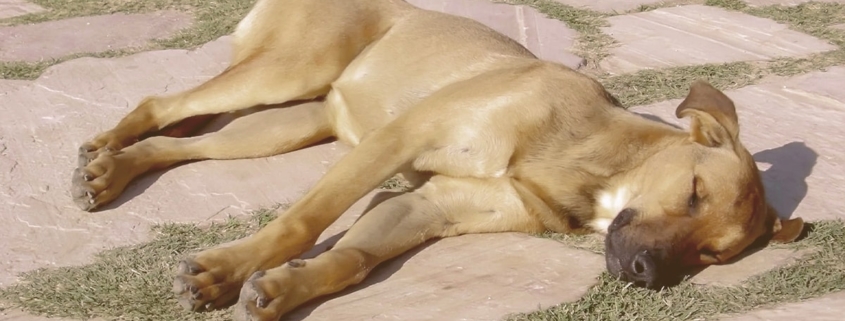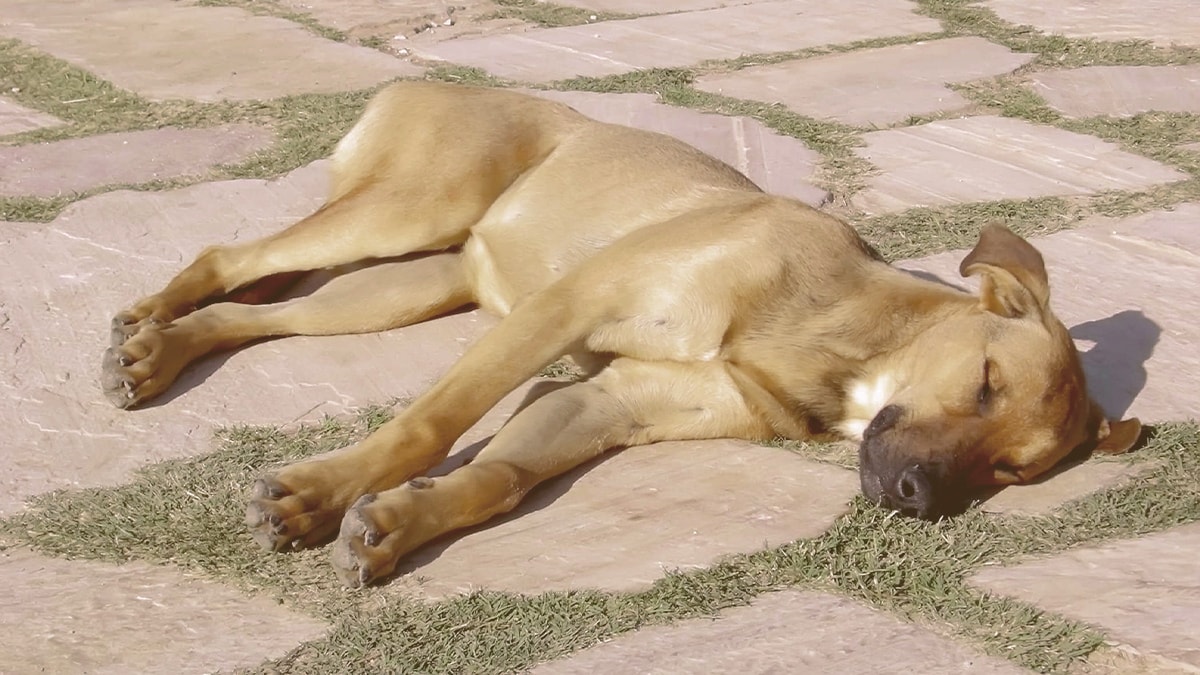
Heat Stroke In Dogs: Symptoms, Prevention and Treatment
Alex Vicente • Updated on August 28, 2023
- This review contains affiliate links. Read more here.
- Not a substitute for professional veterinary help.
Heat stroke is an extremely dangerous and frightening experience. You feel dehydrated, you have no idea what is going on, and above all, you know that something is wrong. The same is true for dogs. Heatstroke can be fatal in humans and animals. It is important to make sure it does not happen to pets. The first step is knowing how to prevent it.
Dogs cannot sweat like humans can and are extra susceptible to heat stroke. Dogs can only pant to cool off, which is why you see dogs panting on hot days. Unfortunately, dogs lack the ability to cool off in extreme conditions like humans can and so need proper attention.
All responsible dog owners want to keep their dogs protected from the elements. Heat stroke is deeply unpleasant when it happens to humans and it is very bad if a dog gets heat stroke, even though it can be reversible to an extent. Keep reading to find out what you need to know about dogs and heat stroke.
Table of Contents
Signs and Symptoms of Heat Stroke in Dogs
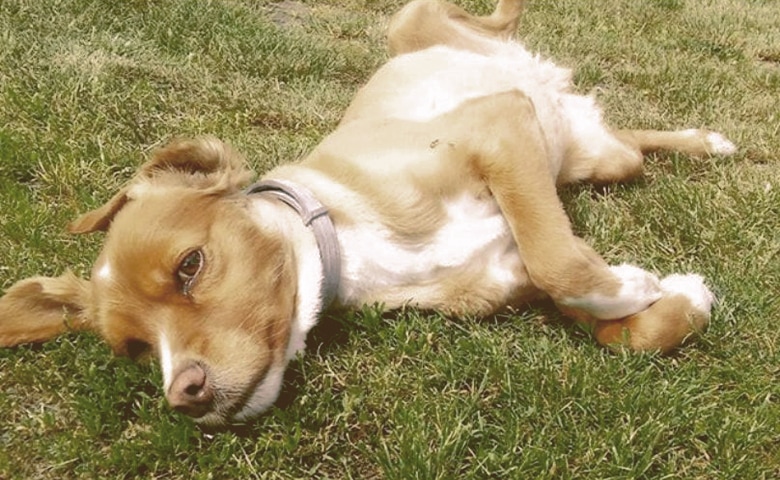
You, as a human, can cool down by taking deep breaths and also by sweating. Dogs cannot sweat as humans can, and as such their ability to cool off like humans is limited. The obvious solutions like jumping in a body of water are not always available options, so bodily functions are the primary means of cooling off.
Dogs have to cool off by panting. Panting passes air over their mouths and dissipates heat. Interestingly, the lining of a dog’s lungs serves as a heat dissipation mechanism, and they have blood vessels in their faces, ears, and feet that can expand to radiate heat outward and cool them down.
- A dog normally has an internal temperature of 100.2ºF (around 37.9ºC) to 102.8 degrees Fahrenheit (about 39.3ºC).
- If a dog’s internal temperature rises past 104 degrees Fahrenheit (about 40ºC), the dog is in danger of serious health problems.
- If a dog’s internal temperature rises past 106 degrees Fahrenheit (around 41.1ºC), you will be very lucky if you are able to bring the heat back down and keep the dog alive.
Fortunately, you can reverse heat stroke if it is caught in the early stages. While heat stroke is a medical emergency, you can reverse heat stroke in dogs by cooling them down slowly. If you try to cool it down too quickly, you run the risk of causing more damage. If you suspect your dog of having a heat stroke, you should take the dog to the veterinarian as quickly as possible.
Heat Stress
Heat stress is essentially the precursor to heat stroke, where a dog or human is feeling the effects of the heat. It is essentially the line between backing off and cooling down or progressing further and potentially getting heatstroke.
The best way to combat heat stress is to pay attention to your dog’s behavior, beyond when they need to make a bathroom stop. When you are familiar with your dog’s behavior and traits, it becomes much easier to notice when they are feeling the effects of the heat. These can include, but are not limited to:
- Lethargy
- Not wanting to move
- Digging to make a cool spot on the ground
- Drooling
- Obvious discomfort
- Excessive panting
These are not necessarily indicators that your dog has heat stroke, but they are warning indicators that more serious problems can occur if you do not address these problems now. As a general rule, if you are feeling the effects of the heat, check on your dog, as they are likely feeling the effects too.
You also need to know when to make your dog stop going, even if your dog does not want to. The dog might want to keep playing even when it is 90 degrees in the shade, regardless of health risks, and you need to know when to make the call to stop and go somewhere to cool off and remain healthy.
Risks for Heat Stroke
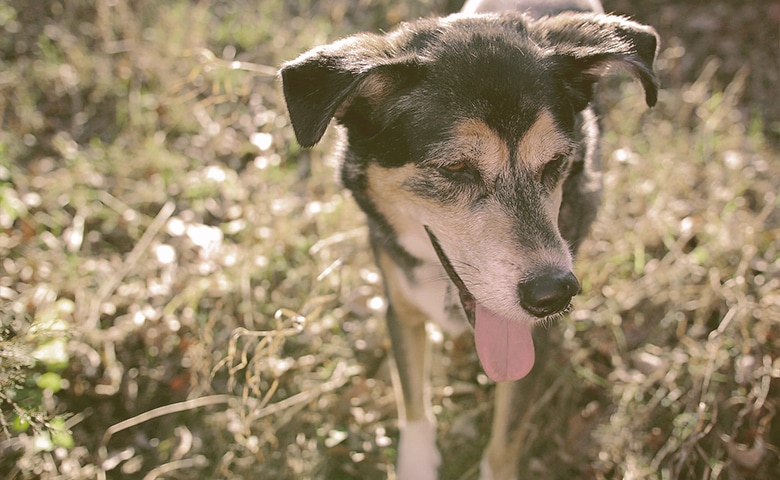
Beyond just making sure you know when your dog is feeling the effects of the heat, you also need to be aware of conditions that can cause the problems which can lead to heat stroke. If you live in the city, you know that the summer heat is held in and stagnated by the tall buildings and concrete.
The humidity worsens the effects, making the air very thick and making it hard to breathe. The sidewalks radiate large amounts of heat, which can burn dogs’ paws and raise their body temperature as well. For this reason, avoid taking your dog for walks on asphalt or concrete during hot days. Try to limit walks to the early morning or evening.
Also, everyone has seen someone leave their dog in a car on a very hot day, accidentally or otherwise. Anyone who has climbed into a car after a day at the beach knows that they essentially become ovens, even if you leave the windows open a crack to let fresh air in. These conditions can give a dog heatstroke and become deadly very quickly.
These are very bad conditions for a dog to be left in. If the car is hot as you drive home, that is fine, but do not leave the car parked and the dog inside for a length of time without the air conditioner running. Fortunately, some cars have a feature that allows you to leave the air conditioning on even with the engine off, the doors locked, and the key out of the car.
Predisposing Factors for Heat Stroke
Aside from factors and circumstances that dog owners can prevent, some dogs have genetic features that make them more disposed to getting heat stroke. As such, these factors require you to be more careful. Having had heat stroke once actually makes it easier for a dog to get it again, as it becomes a predisposing factor.
Some of these factors are present in short-nosed (brachycephalic) dogs, because their airways, essentially, require more force to intake the same amount of air that a dog with a longer snout can pull in. This makes these short-nosed dogs, like pugs, boxers, and bulldogs, more susceptible to heat stroke. However, this does not mean it cannot be prevented.
These breeds with flatter faces have nasal passages and mouths that are much closer together, which makes it harder to effectively dissipate the heat.
Breeds such as Labradors, sheepdogs, German shepherds, and terriers can also be more susceptible to heat stroke because their more hyper attitudes and behavior will lead them to play up to and past the point where they are most at risk of getting heat stroke. In this case, there is nothing genetically wrong, you just need to rein them in.
Another predisposing factor is being obese. This makes it harder for the dog to dissipate heat because their body holds it all in as if they were wrapped in a wooly blanket. The extra body fat acts as an insulating layer and holds in all the heat, preventing them from cooling off. The added layer generates extra heat, and so the cycle repeats, and the possibility of heatstroke increases.
Additionally, the following types of dogs are also more likely to get heat stroke due to predispositions:
- Young puppies: Their bodies have not yet developed fully.
- Older dogs: Their bodies are waning in strength.
- Dogs on certain medications: Certain medications can increase the risk.
Dogs with prior illnesses can also get heat stroke more easily due to prior complications.
How to Prevent Heat Stroke in Dogs

Preventing heat stroke is not too complicated, it just requires some common sense, both where you and your dog are concerned. For instance:
- Do not leave your dog in the car on hot days.
- If you need air conditioning, the dog needs air conditioning.
- Take rest breaks at regular intervals.
- Do not overexert yourself or the dog on hot, humid days.
- Stick to walking on grass if possible when in the sun, not on concrete or asphalt.
- Stick to shady spots when resting outside. You may want to consider getting a dog house for hot weather.
- If you go to the beach, make sure the dog goes swimming too, and provide some form of shade if there are no trees to sit under.
Basically, to prevent getting heat stroke, for yourself and your dog, do not leave them in the car, seek out the shade on hot days, drink plenty of water in reasonable amounts, and do not work too hard. These points are not rocket science, anyone can follow them. Both you and the dog will be happier and healthier for it.
Leave a fan set up or the air conditioning on if you need to leave your dog at home for an extended period of time on hot days. That way they have somewhere to cool off if they are feeling hot and it will not be an excessive amount of cooling. To complement this you may also consider getting a dog cooling mat.
Also, there are sunscreen and sun protection options specifically for dogs:
- My Dog Nose It Moisturizing Sun Protection Balm
- PlayaPup Dog Sun Protective Lightweight Shirt
- Warren London Dog Sunscreen Spray with Aloe Vera
- Dog Sun Protection Visor Cap
- Natural Dog Company PawTection Dog Paw Balm
These will all help keep your dog from getting sunburn, especially if your dog has a pink nose, or exposed skin.
Hydration is Important
Staying hydrated is extremely important, and not just for you. Dogs need to be kept properly hydrated as well. Making sure your dog gets enough water goes a long way toward preventing heat stroke and other problems associated with the condition.
The key is to give your dog reasonable amounts of water at regular intervals if you are out with your dog, especially if you are playing at a dog park, hiking on a trail, or just doing something physically exerting for both of you. If you can, consider bringing a water bottle just for your dog, or packing a bigger one so both of you can drink.
Be careful with how you distribute water, however. Just pouring out a huge bowl of water will do the dog no good. What you need to do is pour out small amounts, like taking sips from a glass of water. This way, the dog can control itself to a point, but you still need to make sure it is not drinking too much too quickly.
You can also prevent heat stroke to an extent by keeping your dog’s water bowl full, especially before you go out with your pet. That way, you know your dog is properly hydrated before you even set off.
Consider a Trimmed Coat
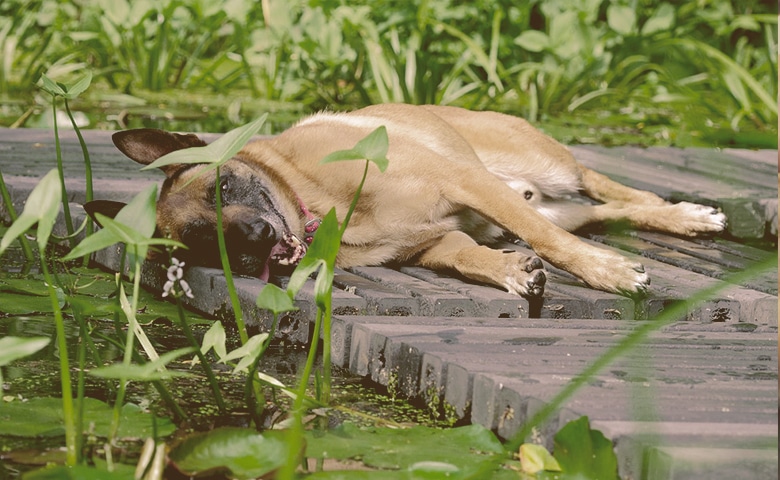
Just as we humans need haircuts, some dogs do too. If your hair gets too long and shaggy, it becomes irritating, cumbersome, and hot. The same is true for certain dog breeds. Haircuts for dogs might seem weird and unnecessary, but they can help the dog regulate its temperature and avoid heat stroke.
The bonus presents itself during shedding season as well. That being said, do not give the dog a skin fade. You need to leave at least an inch or more of fur or hair in order to protect your dog from sunburn and allow their coat to grow to a reasonable, insulating length before winter sets in.
Dogs with long, dark fur can also be more susceptible to heat stroke. If you wear a dark shirt on a very hot day, you will quickly notice that you heat up quicker and remain hot longer than if you wear lighter clothing. This is because dark colors do not reflect the light as well, and the principle is the same for dog fur.
If your dog has dark fur, then you need to pay close attention to the weather, how your dog behaves in the heat and your dog’s water intake. Dogs cannot vent heat in the same way as humans and will overheat quickly if they are not able to cool off.
Monitor the Weather
All the preparation in the world does not help if you do not also pay attention to the weather. If it is 100 degrees Fahrenheit (about 37.8 degrees Celsius) and humid, then it is not the best day to take your dog out for a walk, even to the beach. Taking your dog out on a hot day is fine, but pay attention to the weather and other conditions to make sure the dog stays safe.
Of course, there might be times where the dog is going crazy shut in the house, or your air conditioning might not be working as well, and in those cases, you should seek out a place like a river or a lake. Just watch out for the stones and sand that are in the direct sun, as they will burn your feet and your dog’s paws.
Even gray, muggy days can be dangerous, as the heavy air is more difficult to breathe and will mean you both have to work harder to breathe the same amount of air. Even if the sun is not blazing, you need to be careful as heat stroke can still happen under these conditions.
Generally speaking, pay attention to the weather, and pay attention to your dog, and you should be okay in most normal temperature ranges. This depends on where you live, however. A dog that has lived in Arizona all its life will cope with the heat better than a dog that was raised in Winnipeg, where high temperatures are unlikely.
Clothing to Prevent Heat Stroke
There are various items of pet clothing to keep the heat and sun off of your dog: hats, shirts, cooling vests, etc., along with small booties for their paws. The booties are especially important if you live in the city, where there is not much grass and the sidewalks are superheated by the sun. Booties protect their paws from getting burned.
Sun hats for your dog keep the sun off of their heads which, since dogs cool down by panting, is important. Keeping the direct sunlight off of their heads means dogs can cool themselves more effectively on hot days and so avoid heat stroke more easily. Of course, some convincing may be required to get the dog to wear the hat.
A dog shirt, especially a light-colored shirt, will do a pretty good job of keeping them from getting sunburned or getting too hot on walks. They also work at the beach to keep the sun off, and many are UPF infused to keep the UV rays from causing skin problems, important for dogs with lighter skin or thinner fur.
Finally, cool vests are a little more extreme but useful on hot days. Some work through evaporation, where you soak the vest before putting it on the dog, and then it cools your pet through evaporation. Others have a cooling ice pack in them to provide cooling for a little longer. If they work for the military and law enforcement, they should work for a dog.
How Do Veterinarians Treat Heat Stroke In Dogs?
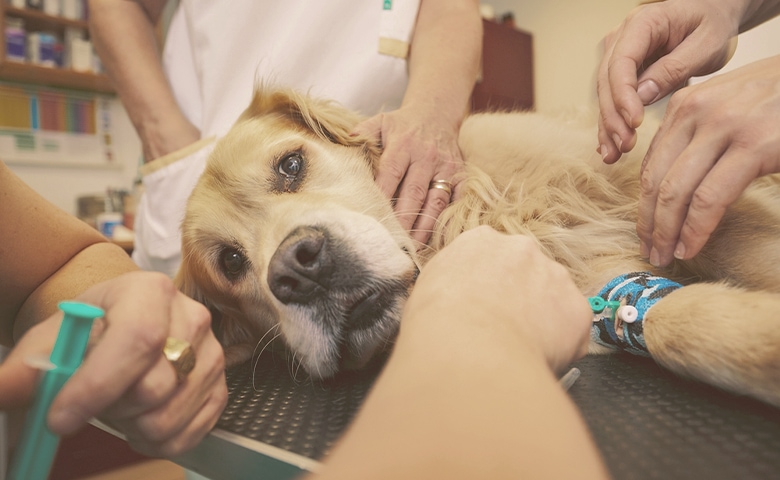
If you think your dog has heat stroke, you should take it to the vet immediately. The treatment that the vet will give your dog may look a bit different from cool water and shade, but it is not difficult.
If you think your dog has heat stroke and you catch it in an early stage, then you have probably avoided serious damage. You should still go to the vet regardless, as there could be other problems you might not see. This may seem like overkill, but it is the safer option.
Long-Term Effects of Heat Stroke in Dogs

Just because your dog appears to be fine after you have successfully cooled them off and got them to rest does not mean there will not be lasting effects if you are unlucky. Long-term effects of heat stroke in dogs can include permanent damage to the:
- Heart
- Lungs
- Liver
This does not mean your dog will have these effects, just that it is possible.
Having heat stroke once actually makes it easier for the dog to catch it again. Their bodies are more susceptible to heat stroke, so it is vitally important that they do not get heat stroke in the first place. Still, dogs with severe heat stroke can require special medication afterward to combat the long-term effects they may suffer.
Treating Heat Stroke in Dogs at Home
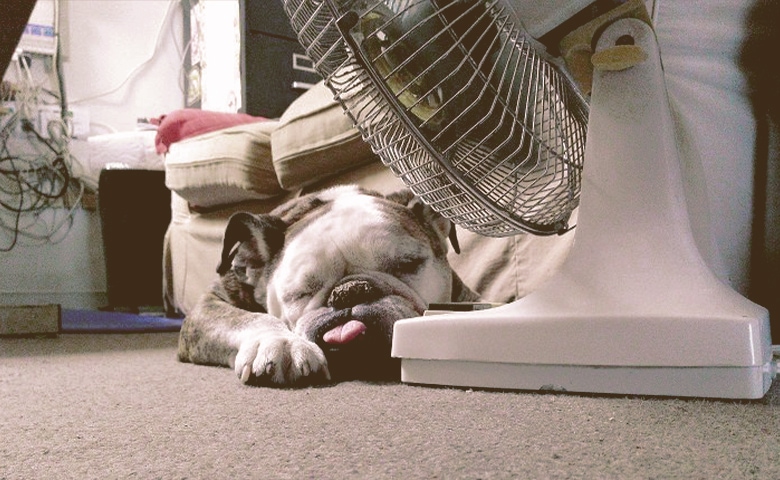
Treating heat stroke at home is simple and will be quicker, as you will have access to the things you need. However, even after performing these treatment methods, you should still take your dog to the vet if you suspect they have had heatstroke, just for an expert eye and opinion.
The first and most important is to get the dog out of the sun and move them into the shade or in the house. If they have heatstroke or the beginnings of it, they will be panting heavily.
- Slowly pour cool, not cold, water over them from nose to tail until their breathing begins to settle, but not enough for them to begin shivering.
- If you do not have that much cool water, a fan on medium speed will work.
- Let the dog drink small amounts of cool water at intervals to gradually lower their temperature, but too much at once will send them into shock and create more problems.
Once you have done all this, take them to the veterinarian. Even with treatment at home, a veterinarian’s expertise is still warranted.
How Long Does a Heat Stroke Last in Dogs?
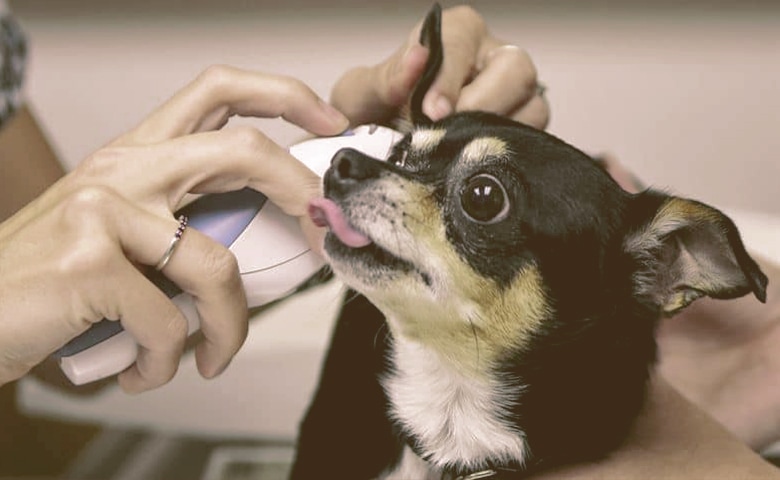
If a dog gets a heat stroke, it will generally last five to seven days. You can combat the dog’s body temperature and lower it right when heat stroke is detected by pouring cool, not cold, water over the dog and allowing it to drain away so that the water does not heat up to the same temperature.
Check the dog’s temperature repeatedly until it has lowered to about 103 degrees Fahrenheit (about 39.4 degrees Celsius). This process should take about 30 minutes to an hour. Do not try to speed it up by pouring large amounts of cold water over the dog, because if the dog’s internal temperature is lowered too quickly, then you run the risk of internal hypothermia and possibly death.
What You Need to Know About Hypothermia
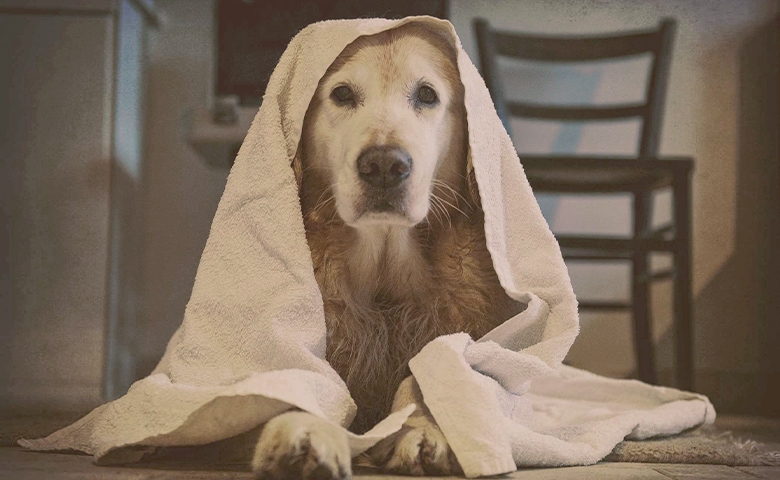
It is important to know how to prevent hypothermia, as treating heat stroke improperly can lead to hypothermia, which is basically the opposite of heat stroke. Whereas heat stroke occurs when a dog’s body temperature rises above 104 degrees Fahrenheit (about 40 degrees Celsius), hypothermia occurs in a dog when its internal temperature falls below 100 degrees Fahrenheit (about 37.8 degrees Celsius), and it can prove fatal if not addressed immediately.
Now, hypothermia, like heat stroke, is serious for humans and dogs alike. Dogs keep themselves warm much like humans do, with shivering, although dogs also have full body fur to aid them in the warming process. Just as with heat stroke, there are certain dogs that deal with cold much better than others.
When it comes to fur, in the cold, more is better. Just as dogs with less fur deal with heat better than dogs with more, dogs with more fur are much more suited to the cold than dogs without. The same goes for dogs that are a little heavier naturally, as the extra body fat and mass acts as an insulating layer to keep the cold out. If your dog is short-haired, you can:
- Wrap your dog in blankets
- Have them wear clothing
- Place a wrapped hot water bottle against their torso
Hypothermia is, like heat stroke, serious but easily preventable with the right clothing and proper attention paid. Make sure your dog is drinking plenty of water, to avoid dehydration, and make sure they have something protecting their paws on very cold days.
Clothing for Dogs to Prevent Hypothermia

Shirts, coats, booties, and bodysuits prevent heat stroke in various versions and help prevent hypothermia in others. Of course, this comes with the precaution that none of these will be particularly effective on an extremely cold, snowy day in the middle of winter unless your dog is a Siberian Husky or a sled dog.
Sweaters for dogs are useful when the temperature is below 40 degrees Fahrenheit (about 4.4 degrees Celsius), to provide that extra shield from the cold and keep the wind out. In this case, it is not sun you need to worry about, but cold and windburn, and this is where the sweater comes in as a protective layer.
Booties are very useful in protecting dogs’ feet, whether that be in the heat or the cold. While the paws of a dog are tougher than a human’s feet, that does not mean they do not feel the cold or heat, and the extreme cold that occurs in winter can be very bad for their paws.
Finally, dog coats work like winter coats for humans, zippers, and all. These work very well when it is particularly cold outside, as many dogs have enough fur to be protected in the moderate cold without trouble.
Conclusion
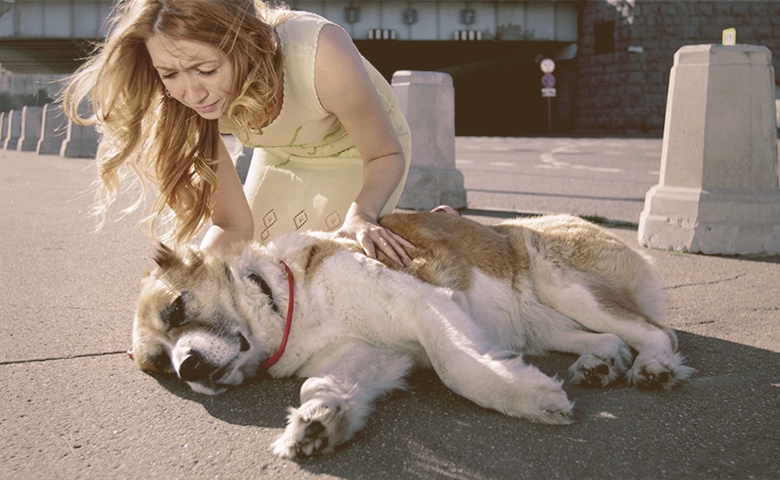
Heat stroke and hypothermia are serious problems for dogs. Fortunately, they can be prevented by taking the proper care to make sure the circumstances that cause either problem never arise. While your dog may get hot or cold when playing outside, with proper attention and care, they will not get heat stroke or hypothermia.
If a dangerous heat stroke does occur, it is treatable if caught early. Follow the proper steps to cool your dog off gradually and have your dog seen by a vet. Remember to prevent it from happening again, as your dog will then be more susceptible to heat stroke later on.
Sources
Breeding Business
PetMD
Healthy Paws Pet Insurance
Hollywood Feed
Skyline Veterinary Specialists
Good House Keeping
RSCA Pet Insurance
Peconic Vet

